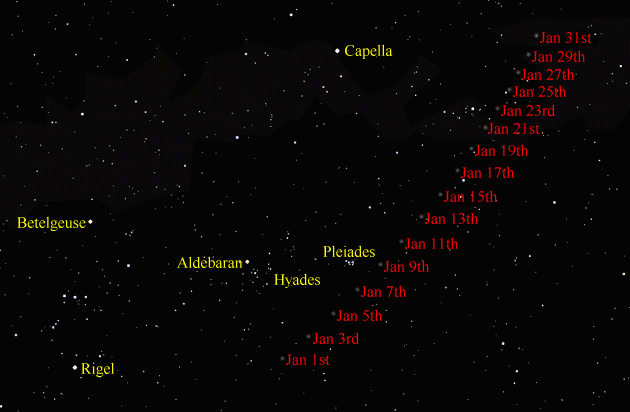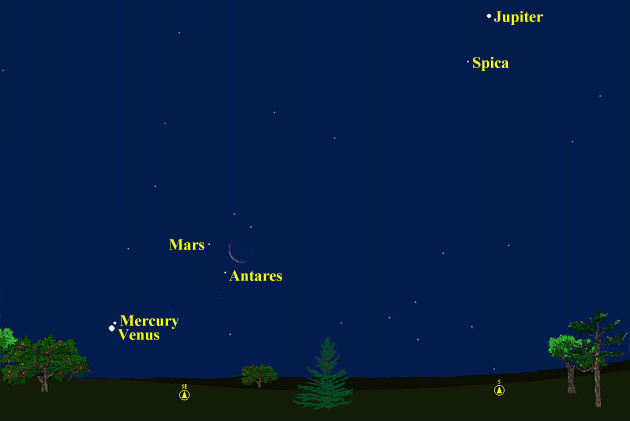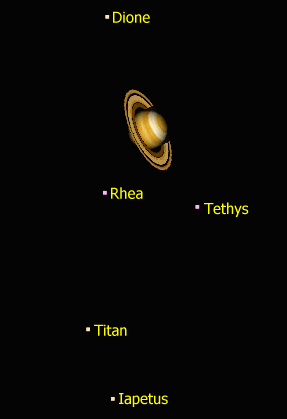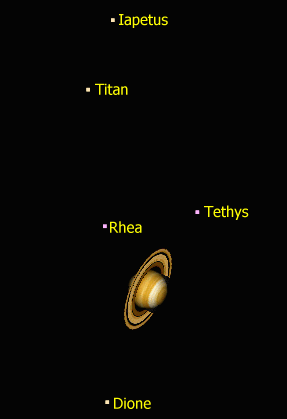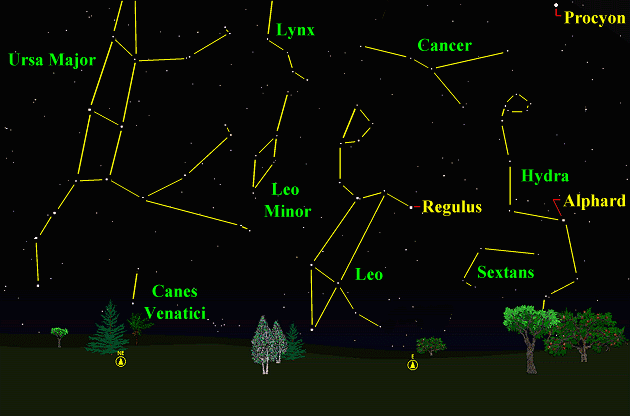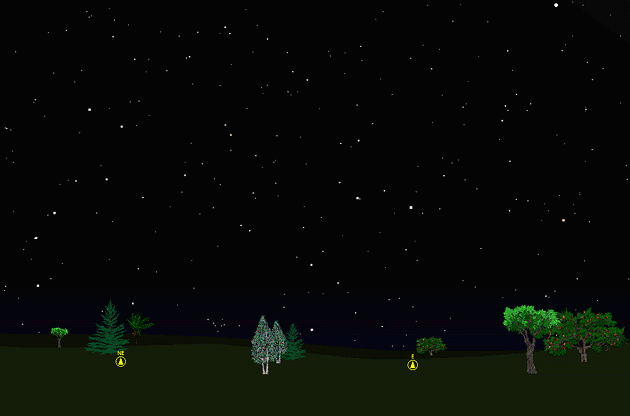The purpose of this new feature is to give scout leaders, educators and naturalists an idea of some of the natural events coming up each month. We will try to cover a variety of natural events ranging from sky events to calling periods of amphibians, bird and mammal watching tips, prominent wildflowers and anything else that comes to mind. We will also note prominent constellations appearing over the eastern horizon at mid-evening each month for our area for those who would like to learn the constellations. If you have suggestions for other types of natural information you would like to see added to this calendar, let us know! Note: You can click on the hyperlinks to learn more about some of the featured items. To return to the Calendar, hit the "back" button on your browser, NOT the "back" button on the web page.
Notes and Images From December 2004: Comet Machholz Drifts Through Eridanus: This image was taken on the evening of December 14th, 2004. An 18mm lens was used with a Nikon D70 camera to capture this image. A red tick mark identifies the comet. The winter Milky Way is visible in the upper right hand corner of the image, with its associated dust clouds and nebulosity. The Orion Nebula is visible in the middle of the "sword." The comet has been consistently faintly visible to the naked eye in dark skies, and is an easy binocular target. It will continue to be visible in January and February. A position chart is included below. Note that all of our sky diagrams are now downloadable as negative (black stars on white sky) black and white charts. These use much less black ink in printing. Simply left click on the charts and you will be taken to a download screen. Click Here to see Comet Machholz. Southeastern Chorus Frogs called from a wet area behind our house on the evening of December 4th. These hardy denizens of flooded fields and ditches can be heard on mild nights throughout the winter into spring and summer. Sky Events for January: Evening Sky: Comet Machholz continues to be faintly visible to the naked eye in dark skies. It is a fine binocular target, and it should be fun to watch it drift by the Pleiades this month. You'll have a much better view in a dark sky away from city lights. The Pleiades should be overhead about 8:00pm CST around mid-month, and this small, bright dipper-shaped cluster of stars should help orient you on the chart below, which shows the comet's position in January. The constellation of Orion is at the lower left of the image. Be sure to allow your eyes time to fully adapt to the darkness. If you have trouble seeing the comet with the naked eye, try using "averted vision." Look to one side of where you think the comet is. This allows the comet's light to fall on areas of your retina more sensitive to faint light. Relax your eyes so that they are focused at infinity. To relax them, it sometimes helps to pretend you're listening to a boring lecture and daydreaming (hey, are you listening?) Bright Saturn continues to provide dazzling views to anyone with a small telescope. Look for it low in the eastern sky after sunset, below the bright stars Castor and Pollux in Gemini (refer to last month's constellation chart.) *Positions shown are for 0:00 Universal Time on the date shown. For our part of the world, this corresponds to the early evening of the day before the date shown. Morning Sky: All five naked eye planets continue to be simultaneously visible in the morning sky in early January. The diagram below shows the view on January 7th, when a waning crescent moon adds to the beauty of the dawn sky. The name Antares means, "rival of Mars," and you can compare the bright star and the planet, which is just above it. This is a great opportunity to see Mercury, as bright Venus guides you to this elusive planet. Jupiter is above the bright star Spica. Saturn is near Castor and Pollux, low in the west at dawn. This chart and the constellation charts below can now be downloaded in negative form (black stars on white sky) for finder charts. Simply left click on the charts to download them. To open them, just navigate to wherever you downloaded them and double-click on them.
The European Space Agency's Huygens probe will enter the atmosphere of Saturn's moon Titan in the early morning hours of January 14th, 2005. If you would like to view and listen to NASA Mission Control live on the web, you can do so by going to the NASA TV Landing Page at: http://www.nasa.gov/multimedia/nasatv/ To get a schedule of events, click the link above and select, Programming, "Live Events, News and Special Event Programs." Remember times are shown in EST. We recommend going to the site in advance to and viewing a program to make sure everything works correctly. If you would like to view Titan at the same time as the Huygens probe is descending into its atmosphere, the views below show how the brighter moons of Saturn will appear at 5:00am on the 14th. The views show the orientations in a reflecting telescope and in a refracting telescope. Titan will be the brightest moon and is visible in most small telescopes. The other moons shown may or may not be visible, depending on the aperture of your telescope. The planet will be about 22 degrees above the western horizon, near Castor and Pollux.
All times noted in the Sky Events are for Franklin, Tennessee and are Central Standard Time. These times should be pretty close anywhere in the mid-state area. Constellations: The views below show the sky looking east at 9:30pm CST on January 15th. The first view shows the sky with the constellation outlines and names depicted. Star and planet names are in yellow. Constellation names are in green. The second view shows the same scene without labels. The planet Jupiter dominates the eastern sky in terms of brightness, but gets no respect from Leo, the Lion, who appears to have his rear paw resting on the giant planet this month. The too-long tail of Ursa Major, the Great Bear, has now cleared the horizon and Hydra, the Water Serpent, rears its head menacingly. Its brightest star Alphard is known as "The Solitary One" because of its somewhat isolated location from other bright stars. Canes Venatici, the Hunting Dogs, also make their appearance. Among the fainter constellations visible in the east are Leo Minor, the Small Lion, Cancer, the Crab, and Sextans, the Sextant.
On Learning the Constellations: We advise learning a few constellations each month, and then following them through the seasons. Once you associate a particular constellation coming over the eastern horizon at a certain time of year, you may start thinking about it like an old friend, looking forward to its arrival each season. The stars in the evening scene above, for instance, will always be in the same place relative to the horizon at the same time and date each January. Of course, the planets do move slowly through the constellations, but with practice you will learn to identify them from their appearance. In particular, learn the brightest stars (Like Regulus and Procyon in the scene looking east), for they will guide you to the fainter stars. Once you can locate the more prominent constellations, you can "branch out" to other constellations around them. It may take you a little while to get a sense of scale, to translate what you see on the computer screen or what you see on the page of a book to what you see in the sky. Look for patterns, like the stars of the "Big Dipper." The earth's rotation causes the constellations to appear to move across the sky just as the sun and the moon appear to do. If you go outside earlier than the time shown on the charts, the constellations will be lower to the eastern horizon. If you observe later, they will have climbed higher. As each season progresses, the earth's motion around the sun causes the constellations to appear a little farther towards the west each night for any given time of night. If you want to see where the constellations in the above figures will be on February 15th at 9:00pm CST, you can stay up till 11:00pm CST on the January 15th and get a preview. The westward motion of the constellations is equivalent to two hours per month. For instance, if you want to see what stars will be on your eastern horizon on April 15th at 9:00pm CST (3 months later), you would need to get up at 3:00am CST in the morning on January 15th (3 months times 2 hours/month = 6 hours). A good book to learn the constellations is H. A. Rey's
classic, The Stars, A New Way to See Them. Rey's depictions of the
constellations and witty commentary are terrific. A good general reference book on astronomy is the Peterson
Field Guide, A Field Guide to the Stars and Planets, by Pasachoff.
The book retails for around $14.00. A good beginners software program for learning the night sky
is the Starry Night Beginner program. Visit the Starry Night web site at
www.starrynight.com The program retails for around $30.00 and
contains a wealth of information.
Circumzenithal Arcs: Fall, Winter and Spring are good times to watch for these beautiful arcs that form directly overhead. Be sure to look upward in the late afternoon anytime you have wispy cirrus clouds in sky.
Amphibians:
Contrary to popular belief, a lot of things happen with amphibians in January. To see them, though, you have to be out in the sort of weather that makes most (sane) people stay indoors. The trick is to go out on mild (50 degrees Fahrenheit or warmer) rainy nights. For safety, it is important that you have another person with you to watch for traffic as you slowly drive the back roads, looking for things that cross the road in front of you and frequently stopping and listening. Upland Chorus Frogs, who can have breeding choruses as early as December, are calling more frequently now. In January, calling Spring Peepers become more common (they have been observed calling every month in Tennessee). Wood Frogs have their short-lived breeding choruses in woodland ponds, where they are often joined by Spotted Salamanders. Tiger Salamanders also breed in January in less wooded areas and the eggs of both can often be found this time of year. For photos of common winter egg masses, click here. Southern Leopard Frogs are also sometimes calling on mild January nights. We have seen Northern Cricket Frogs, Green Frogs, Bullfrogs and American Toads foraging in January. And just about anything is possible. On January 22, 1999, we found a Eastern Spadefoot out in the stormy weather. That same day a tornado ripped through Clarksville, Tennessee, doing much damage to the Austin Peay campus. January is an exciting time of year to look for herps!
Birds: If you walk grassy fields that have some wetter areas, you may flush a Short-Eared Owl, a winter resident in Tennessee. We have flushed them from fields at Pardue’s Pond near Ashland City, along the roads that go to Pace Point near Big Sandy, Tennessee, at Britton Ford near Dover, Tennessee and at Savannah Bottoms, south of Savannah, Tennessee. These birds tend to occupy the same habitat as Northern Harriers, so if you see Harriers over grassy fields, be on the lookout for the owls. They often begin flying in the late afternoon, coursing over the fields like a Harrier. It’s a good idea to check any “Northern Harrier” you see in the late afternoon to make sure it’s not a Short-eared Owl. Now is also the time to walk pine and cedar thickets to look for rare owls like Long-eared Owls and Northern Saw-whet Owls. This is also the perfect time of year to scan for stick nests as you drive along state highways and interstates (preferably with someone else doing the driving!) They are much easier to spot now that the leaves have fallen. You can map out the location of the nests you discover, and then check them to see if they are occupied later in the season. In this manner I located quite a few stick nests last year. Many were later occupied by nesting hawks, and we discovered one occupied Great Horned Owl's nest in the first week of February and were able to watch the nest until the young fledged in May. It was a wonderful experience. If you do find an occupied nest, please respect the birds and do not try to approach the nest. Doing so will stress the birds and may cause them to abandon the nest. If you find a young bird on the ground, leave it where it is. The parents will continue to care for it on the ground. Sometimes well meaning people "rescue" such birds and many times the end result is a bird condemned to living its life in a cage. You probably have already put out your bird feeders, but if you haven’t you're missing out on a lot of good looks at winter feeder birds. This is a great time of year to start learning your birds. Watch and listen for winter residents such as White-throated and White-crowned Sparrows, Yellow-bellied Sapsuckers, Red-breasted Nuthatches, Golden-crowned Kinglets and Brown Creepers. Recommended: Bird Finding in Tennessee, Michael Lee Bierly. A classic guide to finding birds in Tennessee. The Sibley Guide to Birds, David Allen Sibley The Sibley Guide to Birds of Eastern North America, David Allen Sibley This new Sibley Guide covers only eastern North America, is quite compact, and is less expensive than the larger Sibley. An inexpensive guide for beginners is the Golden Guide for Birds. Archives (Remember to use the back button on your browser, NOT the back button on the web page!)
Natural Calendar
December 2004
Natural Calendar
November 2004
Natural Calendar
September 2004
Natural Calendar
February 2004
Natural Calendar
December 2003
Natural Calendar
November 2003
Natural Calendar
September 2003
Natural Calendar
February 2003
Natural Calendar
December 2002
Natural Calendar
November 2002 Nature Notes Archives: Nature Notes was a page we published in 2001 and 2002 containing our observations about everything from the northern lights display of November 2001 to frog and salamander egg masses. Night scenes prepared with Starry Night Pro software All photographs Ó2005 LEAPS
|
